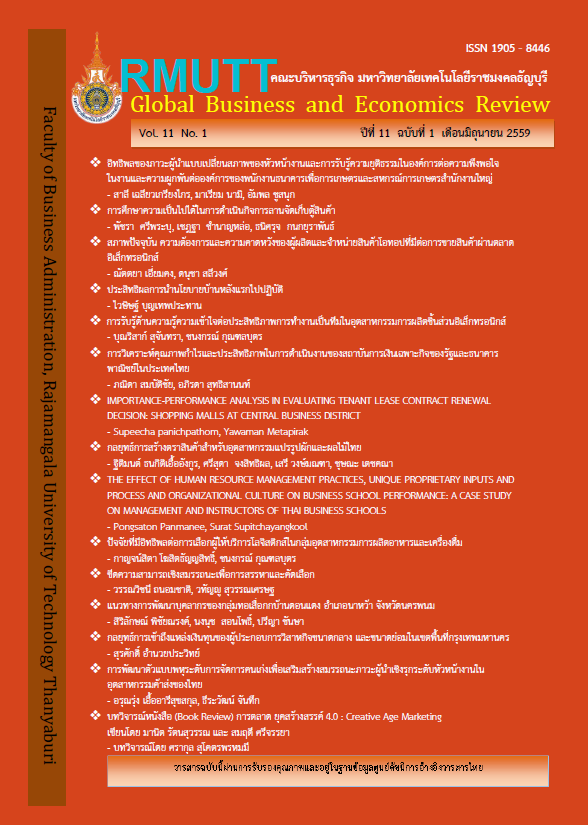COMPETENCY FOR RECRUITMENT AND SELECTION
Keywords:
Competency, Recruitment, SelectionAbstract
The development and introduction of human resource competency have currently been found almost in all primary human resource management functions in many today companies. In most business organizations, this has also been expected by their management teams. This is because integrating the use of human resource competency as part of techniques in managing or developing their human resources allows the management teams to acknowledge, and be aware of their current human resources capabilities which could benefit them in developing new effective business strategic plans. Forms of competency can be devided into two major parts – 1) the explicite one refers to employees’ Applying the competency on recruitment and selection process can therefore be viewed as one effective orgnaizatonal strategiy allowing companies to gain a competitive advantage in business through the management and development of thier own human resources. competences, which can be easily seen or scrutinized such as knowledge and skills; 2) the tacit one refer to employees’ invisible competences which consist of values, self-image, traits, and motives. The beginning of adopting competency based strategy requires both human resource department and all managers to work together in discussing, reviewing and summarizing a list of needed competencies the employees should have. The three types of competency are 1) Core Competency, 2) Managerial Competency and 3) Functional Competency. By defining a list of competency, companies can improve them to their people so that they can perform their jobs with their full potentials. Human Resource Department has therefore been asked to think about redesigning the way they do their jobs and search for better ways in performing all their HR work functions. In addition, when selecting new candidates, applying competency based selection practices could help companies to distinguish the most suitable candidates from a number of applicants. This can be done by considering possible ways which competencies could be used as effective employee selection selection techniques and measurable criteri
References
นิสดารก์ เวชยานนท์. (2549). Competency-Based Approach. กรุงเทพฯ: กราฟิโก ซิสเต็มส์ จำกัด.
บริษัท ปูนซิเมนต์ไทย จำกัด(มหาชน). (2551). ร่วมงานกับเอสซีจี. วันที่ค้นข้อมูล 10 พฤษภาคม 2558, เข้าถึงได้จาก http://www.scg.co.th/th/06career_scg/03_internship_trainee_blog.html.
สุกัญญา รัศมีธรรมโชติ. (2551). การจัดการทรัพยากรมนุษย์ด้วย Competency Based HRM. กรุงเทพฯ: ซีเอ็ดยูเคชั่น จำกัด.
สำนักงานข้าราชการพลเรือน (ก.พ.) (2556). แนวทางการยกระดับขีดสมรรถนะของบุคลากรภาครัฐ พ.ศ. 2556-2558 วันที่ค้นข้อมูล 11 เมษายน 2558, เข้าถึงจาก http://www.ocsc.go.th/ocsc/th/files/CSTI/D%20menu/stategic/strategy%2002.pdf.
Barrelt, G.V. and Depinet, R.L. (1991). A reconsideration of testing for competence rather than for intelligence. American Psychologist, 46, 1012-1024.
Caldwell, D.F. and O’Reilly, C.A. III. (1990). Measuring job-person fit with a profile comparison process. Journal of Applied Psychology, 75, 648-657.
Dubois, D. and Rothwell, W. (2004). Competency-based human resource management. USA: Daries-Black.
Jaridan, M, (1998). Core competence: what does it mean in practice? Elsevier, 31(1), 60-71.
King, A.W., Fowler, S.W. and Zeithaml, C.P. (2011). Managing organizational competencies for competitive advantage: the middle-management edge. Academy of Management, 15(2), 95-106.
McCleeland, D.C. (1973). Testing for competence rather than for “intelligence”. American Psychologist, 28, 1-14.
Nankervis, A., Compton, R., & Baird, M. (2005). Human Resource Management: Strategies and Processes. (ed. 5). Southbank, Vic: Thomson Learning.
Noe, R. A., Hollenbeck, J. R., Gerhart, B., & Wright, P. M. (2012). Human Resource Management: Gaining a Competitive Advantage. (Ed 8). UK: McGraw-Hill Irwin.
Roberts, G. (2004). Recruitment and selection: a competency approach. British: The Cromwell Press, Wiltshire.
Rowe, C. (1995). Clarifying the use of competence and competency models in recruitment, assessment and staff development. Industrial and Commercial Training, 27(11), 12-17.
Ulrich, D., 1997. Human Resource Champions. The next agenda for adding value and delivering results, Boston: Harvard Business Review Press.
Downloads
Published
How to Cite
Issue
Section
License
The articles published in this journal are the intellectual property of their respective authors.
The views and opinions expressed in each article are solely those of the individual authors and do not reflect the positions of Rajamangala University of Technology Thanyaburi or any of its faculty members. All components and content of each article are the sole responsibility of the respective authors. In the event of any errors, the authors shall bear full responsibility for their own work.








